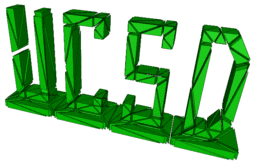| Michael Holst | ||
| https://ccom.ucsd.edu/~mholst/ |
Distinguished Professor of Mathematics and Physics UC San Diego |
|
|
Applications of
MC
in Biophysics
The solvent accessibility of a tRNA has been used to drive an adaptive simplex bisection algorithm in MC. Below is a 2D ``cartoon'' of the situation; the actual 3D case appears here. Keep clicking the pictures to zoom in further on the adapted mesh, which has a fractal-like nature. 
The number of vertices in the finest mesh is 14,489, whereas the number of simplices (triangles in this case) is 28,960. The solvent region in which the tRNA lies is 2000 angstroms wide in each direction. Twenty-seven bisection steps are taken to isolate the implicitly defined molecular skin, so that the element diameters around the skin are on the order of 1.5e-6 angstroms. To achieve a similar resolution around the skin using the uniform mesh methods would require around 133 million mesh points in each coordinate direction, or about 1.8e+15 total mesh points, rather than the 14,489 points used in the adaptive method. |
